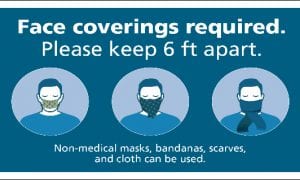Although originally not a part of the day to day guidance for helping slow the spread of COVID-19, more and more of the authorities and health officials have come around to all but insisting upon their use.
As more is learned about this virus, how it spreads and how infectious it is, the science is showing that reducing the possibility of droplets getting into the air, can seriously reduce the opportunity for exposure. Because of the sometimes close quarters at Park Tower, in the halls, elevators and other locations, it was professional guidance about face coverings, which led to the PTCA Board insisting they be used and warning Owners could be fined as an enforcement mechanism for the requirement.
Some recent studies, as reported by SFGATE Online, conclude through statistical models that face coverings could seriously help flatten a 2nd or 3rd wave of the pandemic. “‘We show that, when face masks are used by the public all the time (not just from when symptoms first appear), the effective reproduction number, Re, can be decreased below 1, leading to the mitigation of epidemic spread,’ the scientists wrote in the paper published Wednesday by the Proceedings of the Royal Society A.” They also theorize why communities such as in Taiwan, which has nearly universal face covering use, have been the least impacted by the pandemic.
There are many sources you can GOOGLE, which have more information, but below is an excerpt and link to this particular reporting:
Study: 100% face mask use could crush second, third COVID-19 wave
“We’ve all heard it many times: Wear a face covering — indoors, outdoors, on trains and buses. At work, in the supermarket and at church.
But now a new modeling study out of Cambridge and Greenwich universities suggests that face masks may be even more important than originally thought in preventing future outbreaks of the new coronavirus.
To ward off resurgences, the reproduction number for the virus (the average number of people who will contract it from one infected person) needs to drop below 1.0. Researchers don’t believe that’s achievable with lockdowns alone. However, a combination of lockdowns and widespread mask compliance might do the trick, they say….”
Click Here to view the entire article from the source.








